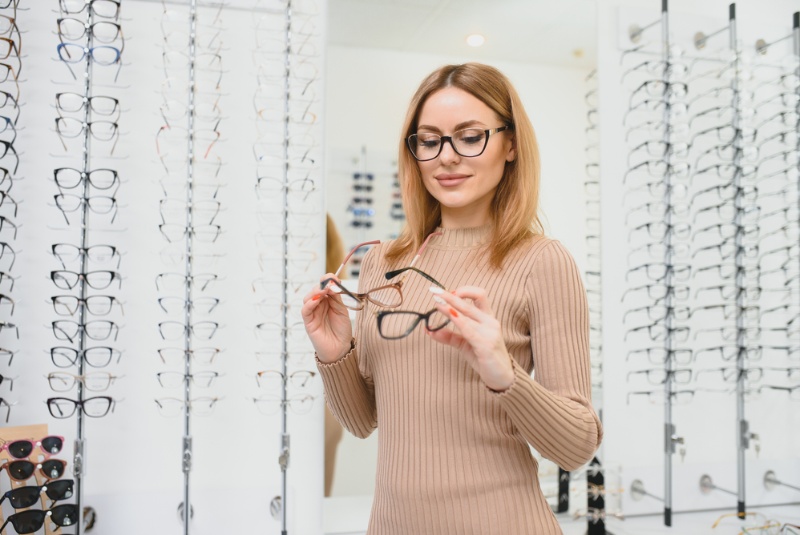Choosing the perfect pair of glasses is not only about fulfilling your prescription needs but also about finding eyewear that complements your unique features and lifestyle. With the vast variety of frames, lens options, and styles available, making the right choice can feel overwhelming.
1. Understand Your Face Shape
The shape of your face plays a major role in finding frames that enhance your natural features. Here’s a breakdown of frame suggestions for different face shapes:
- Oval Face: With balanced proportions, almost any frame style will suit you. Rectangular frames can emphasize the harmony of an oval face, creating a polished look.
- Round Face: Angular frames add definition, giving a leaner look to round faces. Rectangular or square frames add structure, elongating your face shape.
- Square Face: Rounded or oval frames can soften angular features, bringing balance and a touch of subtle contrast.
- Heart-Shaped Face: Frames that are wider at the bottom or have a thin rim can balance the broad forehead, harmonizing the face’s shape.
2. Consider Skin Tone and Frame Colors
Your skin tone can enhance or clash with your frames. Knowing your tone (warm or cool) helps you find colors that naturally complement your complexion.
- Cool Tones: Jewel-toned frames, such as deep blues, purples, or emerald greens, typically look great with cooler skin tones.
- Warm Tones: Frames in earthy hues, such as browns, golds, or olive greens, bring out the warmth of your complexion.
3. Prioritize Comfort
While style matters, comfort is essential for glasses you’ll be wearing frequently. Ensure the frames don’t pinch your nose or temples and that the weight is evenly distributed to avoid pressure points. Look for frames that are light enough to prevent marks on your nose bridge but sturdy enough to last.
4. Choosing Lens Material
Lens materials vary based on prescription strength, durability, and weight. Select one that meets your needs for comfort and functionality:
- Polycarbonate: Known for its lightness and impact resistance, polycarbonate is ideal for sports and kids’ eyewear.
- Trivex: Similar to polycarbonate in durability but with a higher optical quality, suitable for those seeking both resilience and clarity.
- High-Index Plastic: Thin and lightweight, high-index lenses are perfect for those with stronger prescriptions who want to avoid thick, heavy lenses.
- Glass: Offers exceptional clarity and scratch resistance but is heavier than other materials, which may be less comfortable for extended wear.

5. Think About Your Lifestyle
Consider the primary purpose of your glasses. Are they for daily wear, sports, reading, or screen use? Sports enthusiasts, for example, might look for durable frames with flexible materials, while people who work on computers may benefit from blue-light-blocking lenses.
6. Keep Your Prescription Updated
Before purchasing new eyewear, ensure your prescription is up-to-date to avoid eye strain or blurred vision. Consulting with your optometrist for a precise prescription ensures you get glasses that meet your vision needs exactly.
7. Consider Lens Coatings
Lens coatings can enhance the functionality and lifespan of your eyewear:
- Anti-Reflective Coating: Reduces glare from screens and improves clarity, especially for night driving.
- UV Protection: Protects your eyes from harmful ultraviolet rays.
- Scratch-Resistant Coating: Increases durability, particularly useful for active lifestyles or kids.
8. Get Expert Help
If you’re unsure which frames suit you best, don’t hesitate to consult an optician. They can guide you on frame choices based on your prescription, face shape, and style preferences.
9. Take Your Time
Choosing the right pair of glasses shouldn’t be rushed. Try on different styles, shapes, and colors to find what feels and looks best. A well-chosen pair of glasses can not only enhance your features but also reflect your personality.
10. Explore Online Options
Many online retailers offer virtual try-on tools, allowing you to see how various frames look on your face shape. However, ensure the retailer has a good return policy so you can make adjustments if the frames don’t meet your expectations.
Buying the perfect pair of glasses involves a balance of style, comfort, and functionality. By taking into account factors like face shape, skin tone, and lifestyle needs, you’re more likely to find frames that meet both aesthetic and practical requirements. Remember, your glasses are a vital part of your daily life, so choosing the right pair can enhance your confidence and comfort.




